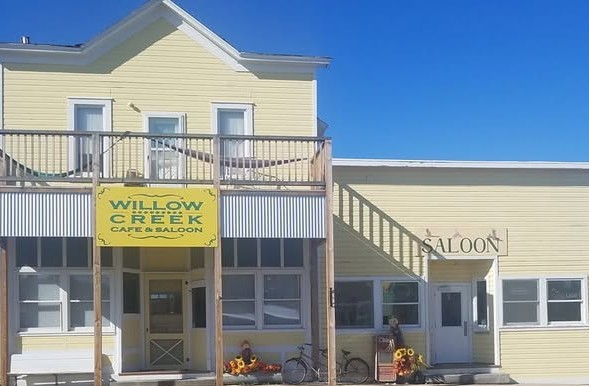Lewis & Clark and the Three Forks of the Missouri
The town of Three Forks derived its name from the headwaters of the Missouri which is the confluence of the three rivers that are the source of the longest river system on the continent, the Missouri-Mississippi drainage. In 1805, Captains Meriwether Lewis and William Clark and the Corps of Discovery camped at the headwaters ofthe Missouri River. They named the southern fork Gallatin in honor of Albert Gallatin, Secretary of the Treasury; the middle fork, Madison, in honor of James Madison, Secretary of State; and the northern fork, Jefferson, in honor of President Thomas Jefferson.
Located in the renowned Gallatin Valley, the headwaters area includes the towns of Three Forks, Willow Creek, Trident, and Logan, up the Jefferson toward Whitehall, up the Madison toward Harrison, and down the Missouri toward Townsend. A tributary of the Jefferson River, Willow Creek, was named “Philosophy River” by Lewis and Clark.
The area of the headwaters and surrounding the town of Three Forks has some of the most colorful legends and early day history of any region in Montana. The headwaters area was a natural crossroads and hunting ground for various Native American tribes, such as the Blackfeet, Shoshone, Flathead, and Crow, many years before Lewis and Clark arrived. Nearby is the Madison Buffalo Jump State Park where buffalo were hunted until about 200 years ago.
Sacajawea, the Indian woman who was interpreter and guide for the Lewis and Clark Expedition, was captured as a child near the headwaters in 1800. She was taken by the Mennetaree tribe to the Mandan Village in the Dakota Territory. Upon returning with the Corps of Discovery, she recognized this area and knew she was nearing her homeland.
John Colter, a member of the Expedition, came back here to trap beaver. This is where he made his famous “naked” run for his life in 1808. He was the first white man to visit Yellowstone Park.
A trading post was established by thirty-two men representing the Missouri Fur Company in 1810, among them Colter and George Drouillard who was also on the Lewis and Clark Expedition. The post was unsuccessful due to hostile Indians and grizzly bear attacks.
Other famous fur trappers and traders such as Jedediah Smith, Jim Bridger, William Sublette, and Kit Carson also explored here. In 1832, Kit Carson was ambushed below the cliffs north of Trident and wounded in a skirmish with Blackfoot Indians. In 1840, Father DeSmet spent his first summer in Montana in at the headwaters doing missionary work with the Crow and Flathead Nations.
In 1862, Gallatin City was founded at the headwaters by a group of Missourians who believed it would be the head of navigation on the Missouri. They thought the gold discoveries in Virginia City, Helena, and elsewhere in Montana, would turn this area into a crossroads for miners, settlers, and freighters traveling between the gold fields. When it was determined that would not be the case, due to the “great falls” above Fort Benton, the town was moved across the river in 1865 to catch the stagecoach trade. It was named Gallatin City II and became the first county seat. When the county seat was moved to Bozeman and the Northern Pacific Railroad bypassed Gallatin City II, the town began to decline.
In 1867, “Initial Point”undefinedwhere the land survey of the entire state of Montana had its start and radiated out to the state’s bordersundefinedwas located near the town of Willow Creek, a few miles from Three Forks.
“Old Town” is the original Three Forks and was described as a Gallatin City suburb in 1885. It was known at one time as an “English Colony” because it was a place where British first families sent their wayward sons to “sow their wild oats.” Other Englishmen embarked in the horse and cattle business. Neither venture profited. Old Town was at one time owned by the Anaconda Copper Company.
The Three Forks of today owes its existence to the establishment of the Milwaukee Railroad in 1908. The location was chosen by J. Q. Adams, Milwaukee Railroad Land Agent. The railroad era lasted until March 25, 1980, when the last Milwaukee Train pulled out of Three Forks.
Lewis & Clark Historic Sites
Lewis Rock – From Fort Rock looking north across the Gallatin River stands what is now called “Lewis Rock.” Lewis ascended this point to view and chart the rivers and surrounding country. He writes “ascended the point of a high limestone cliff from whence I commanded a most perfect view of the neighboring country” Lewis Rock is located outside the park boundary and is on private property.
Parker Homestead – The homestead consists of 1.67 acres and a typical sod-roofed pioneer building. It was built and lived in by Net and Rosa Parker in the early 1900s. In 1997, it was repaired by the Parks Division of the Fish, Game, and Wildlife with the aid of local citizens to prevent further structural decline. The homestead presents a rare opportunity for photographers and the artist with its sod-roofed log cabin nestled under a few large cottonwoods.
A plaque explains the life of the Net Parker family’s life on the homestead, as well as the later family of Orville Jewett. Well worth the visit for everyone interested in the early homestead life of Montana pioneers. The homestead is located just a few miles southwest of Three Forks on US Highway 287.
Fort Rock – As Lewis views the country, he notes “between the middle and SE fork, there is a handsome site for a fortification.” This site is now called Fort Rock though a fort had never been established. Today, an excellent interpretive center and picnic area welcome travelers.
Lewis & Clark Encampment – The Corp of Discovery camped at this location from July 27-30, 1806. They stayed three days, Lewis’ journal explains, “believing this to be and essential point in the geography of this western part of the continent I determined to remain at all events until obtained the necessary data for fixing its latitudes longitude.”
Sacajawea Capture Site – Lewis writes, “Our present camp is precisely on the spot that the Snake Indians were encamped at the time the Mennetaree of the Knife R. first came in sight of them five years since. From hence they retreated about three miles up Jefferson’s river and concealed themselves in the woods, the Mennetaree pursued, attacked them, killed 4 men, 4 women, a number of boys, and made prisoners of all the females and four boys, Sah-cah-gar-we-ah Indian woman was one of the female prisoners taken at that time; though cannot discover that she shows any inaction of sorrow in recollection this event, or of joy in being again restored to her native country’ If she has enough to eat and a few trinkets to wear I believe she would be perfectly content anywhere.”
Other Historic Areas
Headwaters Heritage Museum – Thousands of artifacts and memorabilia depicting the history of Three Forks and the Headwaters area (Willow Creek, Logan, Trident, Old Town, and Gallatin City), can be found in the Headwaters Heritage Museum. Among the many interesting displays on the main floor is an old anvil, all that remains of a fur trapper’s trading post built in 1810. An exceptional collection of barbed wire is another exhibit. There is no charge to visit the museum. Membership, donations, memorials and gift-shop profit provide its funding. Books, souvenirs, postcards, and gifts are available in the gift shop. An all-volunteer staff keeps the museum open from June 1 through September 30 from 9 a.m. to 5 p.m. The museum is available year around by appointment. Call (406) 285-4778 for more information.
Headwaters Heritage MuseumGallatin City – In 1862, Gallatin City was built on the Missouri opposite the entrance of the Gallatin River. The Founders thought it would become the metropolis of the territory providing a ferry service for Missouri River traffic. It was later discovered that the great falls would be an insurmountable obstacle.
Gallatin City (2) – In 1863, Gallatin City was relocated because most of the wagon train and stage coach traffic was on the east side of the river. This second Gallatin City encountered brief prosperity with such amenities and a race track and fairgrounds. The Gallatin City Hotel is one of the only buildings that remains and is situated near the entrance of the park on the south side of the road.
Indian Cave – The headwaters was the meeting ground of various Native American tribes, such as the Blackfoot, Shoshone, and Crow. Faint pictographs are the only physical evidence of the tribes passing through; To view the Indian Cave, follow the trail parallel to the road south from the Fort Rock Interpretive Center.
Fort Henry (a.k.a. Fort Three Forks) – Five years after Lewis & Clarks’s arrival at the Headwaters area, a fur post was established by Pierre Menard and Andrew Henry. The fort was occupied by 32 persons including John Colter and George Droulliard of the Lewis & Clark Expedition. The post lasted only five months due to constant attacks by Blackfeet Indians who were hostile to their presence. A blacksmith’s anvil is the only remaining artifact of Fort Henry and is on display at the Headwaters Heritage Museum in Three Forks.







